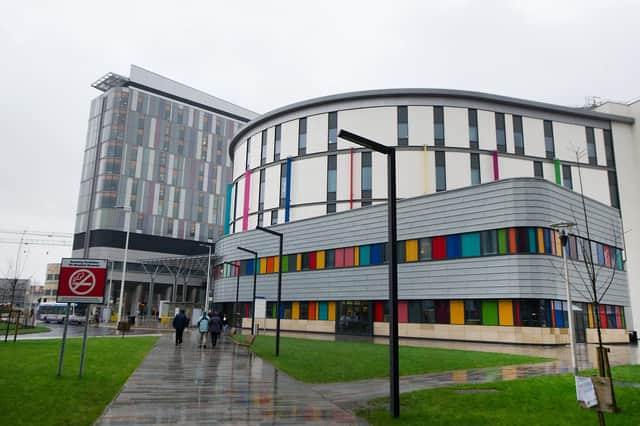Number of people in Scotland waiting for hospital treatment doubles in three months due to second Covid wave


New waiting time figures showed “increasing” numbers experiencing longer waits for inpatient and day case treatment in NHS Scotland.
At the end of December last year, there were 15,128 patients who had been waiting a year or more for such treatment.
Advertisement
Hide AdAdvertisement
Hide AdBut as the second wave of Covid-19 hit hospitals across Scotland, that total had increased to 28,203 by the end of March 2021 – a rise of 86.4 per cent.
The Scottish Government’s legally binding Treatment Time Guarantee states that eligible patients should wait no longer than 12 weeks for their treatment.
But Public Health Scotland revealed that at the end of March this year, 94,781 patients were waiting for either inpatient or day case treatment – with 61,901 having been on the list for 12 weeks or more.
That is an increase of 120 per cent from the total of 28,118 recorded as waiting 12 weeks or more at the end of March 2020 – although this went on to reach 70,396 at the end of June last year, as the pandemic forced hospitals to pause many routine treatments.
In the period January to March this year, 36,582 patients were admitted to hospital for planned treatment, either as an inpatient or on a day case basis.
That is a drop of 20.4 per cent from the number treated in the last three months of 2020, and 43.4 per cent lower than the first quarter of last year.
Meanwhile, when compared to the three months to the end of March 2019, the number being admitted for treatment is 50.2 per cent lower, with the report saying this “highlights the impact the pandemic has had on the number patients admitted”.
The suspension of non-urgent care by some hospitals contributed to numbers waiting for either inpatient or day case treatment increasing.
Advertisement
Hide AdAdvertisement
Hide AdThe total of 94,781 recorded at the end of March is 10.5 per cent higher than it was as of December 31 last year, and was up by 19.6 per cent from the end of March 2020.
Labour health spokesperson and deputy leader Jackie Baillie said: “These statistics plainly show that we are in the midst of a healthcare crisis.”
She insisted that “without urgent action to remobilise the NHS, lives will be lost”, adding newly-appointed health secretary Humza Yousaf has “no time to lose”.
Ms Baillie said: “We have no time to dither and delay. The SNP need to take urgent action to save lives and they need to take it now.”
The published report noted: “The increase in the number waiting in the latest quarter is a consequence of less people being seen due to suspension of non-urgent care by some hospitals mentioned above.”
The report added the “long-term trend demonstrates the total number of patients waiting for treatment has been gradually increasing over time prior to the pandemic”.
The report said: “This growth accelerated between March and June in response to the emergency measures before levelling off for the remainder of 2020.
“In the most recent quarter, there has again been a large increase due to an increase in the number of additions to the list and a decrease in the number of patients being seen.”
Advertisement
Hide AdAdvertisement
Hide AdMeanwhile, other figures showed there were 105,630 Scots waiting for one of eight key diagnostic tests at the end of March – a rise of 4.7 per cent from December last year and 24.9 per cent higher than it had been 12 months previously.
And there were 354,782 patients who were waiting for an outpatient appointment – with this total being 4.2 per cent higher than at the end of December 2020 and 14.1 per cent higher than it was on March 31, 2019, before the pandemic began.
The Scottish Liberal Democrats said the Scottish Government’s 12-week Treatment Time Guarantee had now been broken 402,800 times.
Party health spokesman Alex Cole-Hamilton said that meant “patients are waiting in pain and the law underpinning their rights is in tatters”.
He insisted: “Patients and hardworking staff can’t afford for ministers to be distracted from the job of NHS recovery. Catching up on lost treatments and delayed operations is going to need every ounce of their energy and attention.”
Scottish Conservative health spokeswoman Annie Wells meanwhile, said the numbers waiting for diagnostic tests was “extremely concerning”.
She stated: “The SNP’s new health secretary must tackle these waiting times as a matter of urgency before they completely spiral out of control.
“The pandemic has undoubtedly brought unique challenges for our NHS, but SNP ministers cannot be allowed to deflect blame for these ever increasing waits for patients to be seen.
Advertisement
Hide AdAdvertisement
Hide Ad“Even prior to this crisis, the SNP’s record on hitting health targets simply wasn’t good enough. These constant delays for patients will only be causing them more stress on top of their underlying health problems.”
Scottish Labour leader Anas Sarwar had in March branded the cancer care backlog brought on by the coronavirus pandemic a “national emergency”, with patients travelling hundreds of miles for treatment.
Figures released on Tuesday by Public Health Scotland at the time showed 485 people waited more than two months to start cancer treatment after receiving an urgent referral in the last quarter of 2020.
Comments
Want to join the conversation? Please or to comment on this article.
